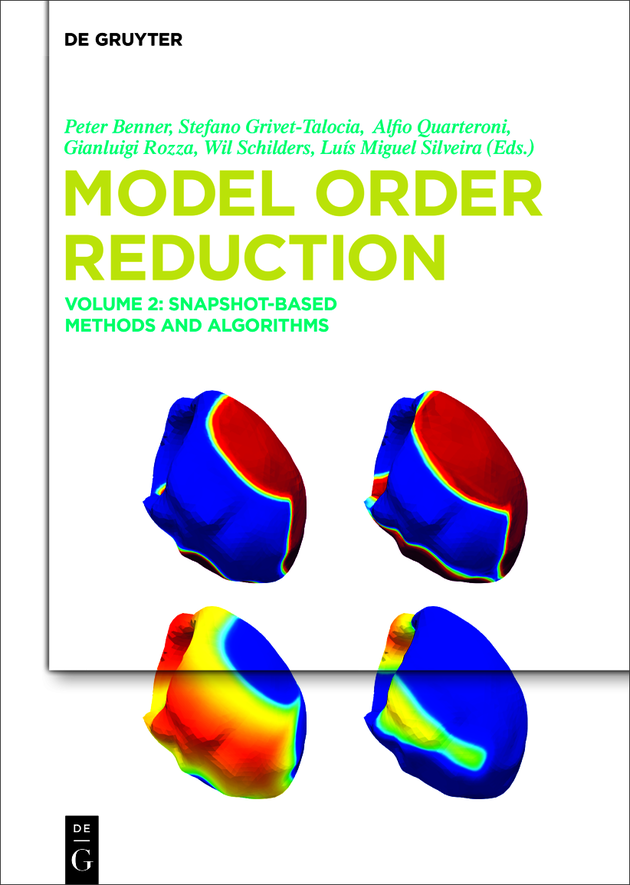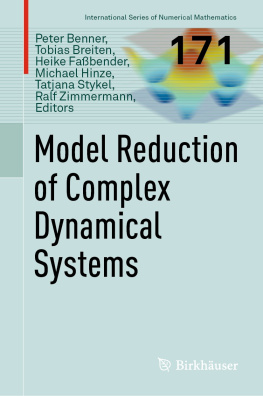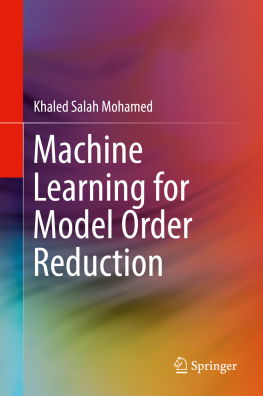Peter Benner - Model Order Reduction
Here you can read online Peter Benner - Model Order Reduction full text of the book (entire story) in english for free. Download pdf and epub, get meaning, cover and reviews about this ebook. year: 2020, publisher: De Gruyter, genre: Home and family. Description of the work, (preface) as well as reviews are available. Best literature library LitArk.com created for fans of good reading and offers a wide selection of genres:
Romance novel
Science fiction
Adventure
Detective
Science
History
Home and family
Prose
Art
Politics
Computer
Non-fiction
Religion
Business
Children
Humor
Choose a favorite category and find really read worthwhile books. Enjoy immersion in the world of imagination, feel the emotions of the characters or learn something new for yourself, make an fascinating discovery.

- Book:Model Order Reduction
- Author:
- Publisher:De Gruyter
- Genre:
- Year:2020
- Rating:3 / 5
- Favourites:Add to favourites
- Your mark:
- 60
- 1
- 2
- 3
- 4
- 5
Model Order Reduction: summary, description and annotation
We offer to read an annotation, description, summary or preface (depends on what the author of the book "Model Order Reduction" wrote himself). If you haven't found the necessary information about the book — write in the comments, we will try to find it.
Model Order Reduction — read online for free the complete book (whole text) full work
Below is the text of the book, divided by pages. System saving the place of the last page read, allows you to conveniently read the book "Model Order Reduction" online for free, without having to search again every time where you left off. Put a bookmark, and you can go to the page where you finished reading at any time.
Font size:
Interval:
Bookmark:

ISBN 9783110671407
e-ISBN (PDF) 9783110671490
e-ISBN (EPUB) 9783110671506
Bibliographic information published by the Deutsche Nationalbibliothek
The Deutsche Nationalbibliothek lists this publication in the Deutsche Nationalbibliografie; detailed bibliographic data are available on the Internet at http://dnb.dnb.de.
2021 Peter Benner, Stefano Grivet-Talocia, Alfio Quarteroni, Gianluigi Rozza, Wil Schilders, Lus Miguel Silveira, published by Walter de Gruyter GmbH, Berlin/Boston
This work is licensed under the Creative Commons Attribution-NonCommercial-NoDerivatives 4.0 International License.
We provide first the functional analysis background required for reduced-order modeling and present the underlying concepts of reduced basis model reduction. The projection-based model reduction framework under affinity assumptions, offline-online decomposition, and error estimation are introduced. Several tools for geometry parameterizations such as free form deformation, radial basis function interpolation, and inverse distance weighting interpolation are explained. The empirical interpolation method is introduced as a general tool to deal with nonaffine parameter dependency and nonlinear problems. The discrete and matrix versions of the empirical interpolation are considered as well. Active subspace properties are discussed to reduce high-dimensional parameter spaces as a preprocessing step. Several examples illustrate the methodologies.
We are grateful to the EU-COST European Union Cooperation in Science and Technology, section EU-MORNET Model Reduction Network, TD 1307 for pushing us into this initiative. This work is supported by European Union Funding for Research and Innovation Horizon 2020 Program in the framework of European Research Council Executive Agency: H2020 ERC CoG 2015 AROMA-CFD project 681447 Advanced Reduced Order Methods with Applications in Computational Fluid Dynamics to P.I. Gianluigi Rozza.
Parametric model order reduction (MOR) techniques have been developed in recent decades to deal with increasingly complex computational tasks. The ability to compute how quantities of interest change with respect to parameter variations provides insight and understanding, which is vital in all areas of science and engineering. Model reduction thus allows to deal with optimization or inverse problems of a whole new scale. Each chapter of the handbook gives an in-depth view of a MOR method, a particular application area, and analytical, numerical, or technical aspects of software frameworks for model reduction.
There exist a large number of MOR techniques used in many areas of science and engineering to improve computational performances and contain costs in a repetitive computational environment, such as many-query and real-time computing []. We assume a given parameterized partial differential equation (PDE) as starting point of the model reduction procedure. Typical parameters of interest are material coefficients, corresponding to physical qualities of the media which constitute the domain where the PDE is solved. Also a variable geometry can be of special interest in a task to find the optimal device configuration. Physical states such as the temperature might be considered an input parameter. It is a task of the mathematical modeling to identify the parameters of interest and how they enter the PDE. Once a parameterized model is identified, the MOR techniques described in this and the following chapters can be used either in a black-box fashion (nonintrusive way) or by intrusive means, which will be explained in detail, whenever this is necessary.
The particular numerical method to solve a PDE is most often not relevant to the model reduction procedure. We will therefore assume there is a numerical method available, which solves the problem to any required accuracy, and move seamlessly from the continuous form to the discretized form.
This chapter covers briefly the functional analysis framework relevant to many, but not all, MOR methods. Presented is the starting point of PDE-oriented MOR techniques, such as the POD method found in Chapter 2 of this volume, the PGD method found in Chapter of this volume.
In particular, Section . Due to brevity of representation, many concepts of functional analysis and theory of PDEs are only touched upon. Many references to the literature for further reading are given.
Projection-based ROM is presented in Section .
Section .
A widely used method to generate an approximate affine parameter dependency is the empirical interpolation method (EIM). The original EIM is presented in Section .
Section .
A brief conclusion and an outlook of the handbook are given in Section .
We briefly cover a few main results of linear functional analysis and the analysis of PDEs. This material serves as a reminder of the underlying concepts of model reduction but cannot replace a textbook on these subjects. For a more thorough background, we refer to the literature on functional analysis [].
Let Rd denote a spatial domain in d=1,2 , or 3 dimensions with boundary . A Dirichlet boundary D is given, where essential boundary conditions on the field of interest are prescribed. Introduce a Hilbert space V() equipped with inner product (,)V and induced norm V . A Hilbert space V() is a function space, i.e., a function uV() is seen as a point in the vector space V, as is common in functional analysis. Each uV() defines a mapping xu(x)R or xu(x)C , depending on whether a real or complex Hilbert space is considered. In many applications, V is a subset of the Sobolev space H1() as V()={vH1():v|D=0} . Vector-valued Hilbert spaces can be constructed using the Cartesian product of V() . Given a parameter domain PRp , a particular parameter point is denoted by the p-tuple =(1,2,,p) . The set of all linear and continuous forms on V defines the dual space V ; let LL(V,V) denote a linear differential operator.
A field variable uV:R is defined implicitly as the solution to a parameterized linear PDE through the operator L:VPV with L(;)L(V,V) and load vector fL()V for each fixed , as
As in the case of function spaces, operators between function spaces form vector spaces themselves, such as L(;)L(V,V) , with L(V,V) being the space of operators mapping from the vector space V to V .
Typical examples of scalar-valued linear PDEs are the Poisson equation, the heat equation, and the wave equation, while typical examples of vector-valued linear PDEs are the Maxwell equations and the Stokes equations. The nonlinear case will be addressed in various chapters as well: Examples of nonlinear PDEs include the NavierStokes system and the equations describing nonlinear elasticity.
Font size:
Interval:
Bookmark:
Similar books «Model Order Reduction»
Look at similar books to Model Order Reduction. We have selected literature similar in name and meaning in the hope of providing readers with more options to find new, interesting, not yet read works.
Discussion, reviews of the book Model Order Reduction and just readers' own opinions. Leave your comments, write what you think about the work, its meaning or the main characters. Specify what exactly you liked and what you didn't like, and why you think so.












